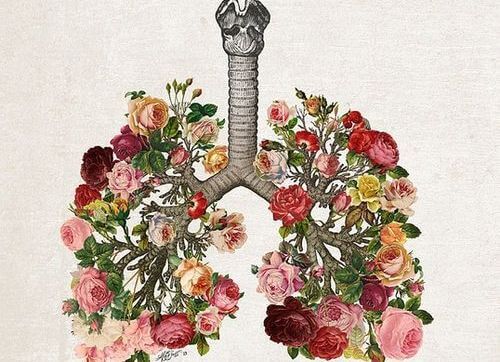What Our Sighs Communicate

They say that a sigh is the spare air we have for someone we are missing. Our sighs communicate many aspects of our emotional life. It is a daily act that seems to allow us to relieve the pangs of our sorrows, like someone who lets out the pains of their soul, trying to find relief, a fleeting consolation when it all hurts too much.
That said… are sighs really the physiological catharsis of our emotional problems? Only partially. People sigh when they feel stressed, frustrated or when sadness torments us with its dark cloud. It is then that our subconscious, in an act of reflex, seems to seek out the reset button to get some fresh air, to liberate ourselves of the pain for a moment.
They say that sighs are the answer to all the questions that got stuck mid-air and that there are sighs that contain more love than any kiss. However, people also sigh for a very concrete reason: to not die.
We could therefore assume that people carry out this biological act simply as an emotional release. However, this is not always the case, because, in fact, if humans didn’t sigh, they would die. Because a sigh is a specific type of breathing that we do involuntarily during the whole day.
With each breath of air that we let out with a sound, we restart our life cycle. This is something both curious and beautiful that we want to share with you.

The involuntary sigh, the vital breath
There are both voluntary and involuntary sighs. The latter in reality constitute a vital support process for our health and to maintain our lungs. The way that this reflex works and is orchestrated in our body obeys a whole fascinating sequence of steps that are worth knowing about.
According to a study carried out at the Stanford University School of Medicine (United States), our brain “chooses” what kind of breathing we need at each moment. The part of our brain which carries out this delicate task consists of two specific types of neurons found in the brain stem, which scientists have familiarly called “sigh buttons”.
This fact is very curious: there are moments in which our alveoli collapse. When this happens, the ability of our lungs to exchange oxygen for carbon dioxide is seriously compromised. So what is the solution? This is when the “sigh buttons” come into action, giving the order to sigh in order to open up the alveoli, allowing double the conventional volume of air of a normal breath to enter.
It is a survival mechanism that we do without realizing it around twelve times an hour. Incredible and marvelous, without a doubt.

Emotional sighs: what we are missing
Karl Teigen is a famous scientist from the Oslo University of Psychology, who has won awards for his studies about these so-called “emotional sighs”. Throughout 2010 he ran several studies, which showed the following:
- People are very receptive to the sighs of others. We almost instantly empathize with someone who lets out a deep sigh.
- However, here comes the most interesting bit: this “connection” is so intense because we generally associate this act with emotional pain
- Voluntary sighs are interpreted by our brains as a release of frustration, disappointment, sorrow, defeat, due to someone we are missing or due to longing. Thus we almost instantly ask: “What’s wrong? What are you thinking about? What are you worried about?”
People empathize much more with the pain of others than with their moments of happiness. It is an instinctive and subtle mechanism that has helped our species to survive as a social group for a long time. Because knowing how to read the needs of others is essential to be able to offer support.

Sighs communicate we need to mentally and physically restart
We now know that sighs are vital to maintain our life cycle in the lungs. An intimate and perfect connection between our brain and the respiratory system. But also, a study carried out at the University of Lovaina shows that we will receive great benefits if, over the course of the day, we find different moments to relax and simply sigh.
This fact is neither new nor strange. The science of breathing slowly and deeply without a doubt strings together many techniques of relaxation, yoga and mindfulness exercises. According to the authors of this study, it would be interesting for us to put the following into practice:
- Find a quiet place where you can mentally relax.
- Sit with your spine straight.
- Lift your chest and rest your hands in your lap.
- Breathe in deeply through the nose for 4 seconds. Hold the breath in for anther 4 seconds and then let out a long sigh with sound for 7 seconds.
This simple exercise, as well as favoring relaxation, enables us to be more present, improve our cognitive abilities and switch off our annoying mental noise.
So, as we can see, a sigh contains fascinating aspects that define us, how we work, what we feel and even how we interact with the environment around us. Don’t hesitate to sigh every day and at every moment to restart the marvelous cycle of life and happiness.
They say that a sigh is the spare air we have for someone we are missing. Our sighs communicate many aspects of our emotional life. It is a daily act that seems to allow us to relieve the pangs of our sorrows, like someone who lets out the pains of their soul, trying to find relief, a fleeting consolation when it all hurts too much.
That said… are sighs really the physiological catharsis of our emotional problems? Only partially. People sigh when they feel stressed, frustrated or when sadness torments us with its dark cloud. It is then that our subconscious, in an act of reflex, seems to seek out the reset button to get some fresh air, to liberate ourselves of the pain for a moment.
They say that sighs are the answer to all the questions that got stuck mid-air and that there are sighs that contain more love than any kiss. However, people also sigh for a very concrete reason: to not die.
We could therefore assume that people carry out this biological act simply as an emotional release. However, this is not always the case, because, in fact, if humans didn’t sigh, they would die. Because a sigh is a specific type of breathing that we do involuntarily during the whole day.
With each breath of air that we let out with a sound, we restart our life cycle. This is something both curious and beautiful that we want to share with you.

The involuntary sigh, the vital breath
There are both voluntary and involuntary sighs. The latter in reality constitute a vital support process for our health and to maintain our lungs. The way that this reflex works and is orchestrated in our body obeys a whole fascinating sequence of steps that are worth knowing about.
According to a study carried out at the Stanford University School of Medicine (United States), our brain “chooses” what kind of breathing we need at each moment. The part of our brain which carries out this delicate task consists of two specific types of neurons found in the brain stem, which scientists have familiarly called “sigh buttons”.
This fact is very curious: there are moments in which our alveoli collapse. When this happens, the ability of our lungs to exchange oxygen for carbon dioxide is seriously compromised. So what is the solution? This is when the “sigh buttons” come into action, giving the order to sigh in order to open up the alveoli, allowing double the conventional volume of air of a normal breath to enter.
It is a survival mechanism that we do without realizing it around twelve times an hour. Incredible and marvelous, without a doubt.

Emotional sighs: what we are missing
Karl Teigen is a famous scientist from the Oslo University of Psychology, who has won awards for his studies about these so-called “emotional sighs”. Throughout 2010 he ran several studies, which showed the following:
- People are very receptive to the sighs of others. We almost instantly empathize with someone who lets out a deep sigh.
- However, here comes the most interesting bit: this “connection” is so intense because we generally associate this act with emotional pain
- Voluntary sighs are interpreted by our brains as a release of frustration, disappointment, sorrow, defeat, due to someone we are missing or due to longing. Thus we almost instantly ask: “What’s wrong? What are you thinking about? What are you worried about?”
People empathize much more with the pain of others than with their moments of happiness. It is an instinctive and subtle mechanism that has helped our species to survive as a social group for a long time. Because knowing how to read the needs of others is essential to be able to offer support.

Sighs communicate we need to mentally and physically restart
We now know that sighs are vital to maintain our life cycle in the lungs. An intimate and perfect connection between our brain and the respiratory system. But also, a study carried out at the University of Lovaina shows that we will receive great benefits if, over the course of the day, we find different moments to relax and simply sigh.
This fact is neither new nor strange. The science of breathing slowly and deeply without a doubt strings together many techniques of relaxation, yoga and mindfulness exercises. According to the authors of this study, it would be interesting for us to put the following into practice:
- Find a quiet place where you can mentally relax.
- Sit with your spine straight.
- Lift your chest and rest your hands in your lap.
- Breathe in deeply through the nose for 4 seconds. Hold the breath in for anther 4 seconds and then let out a long sigh with sound for 7 seconds.
This simple exercise, as well as favoring relaxation, enables us to be more present, improve our cognitive abilities and switch off our annoying mental noise.
So, as we can see, a sigh contains fascinating aspects that define us, how we work, what we feel and even how we interact with the environment around us. Don’t hesitate to sigh every day and at every moment to restart the marvelous cycle of life and happiness.
This text is provided for informational purposes only and does not replace consultation with a professional. If in doubt, consult your specialist.







